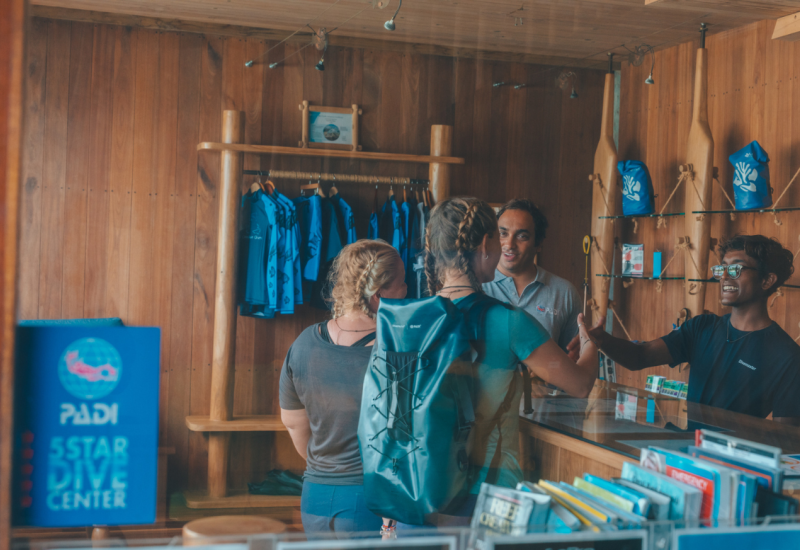A Scuba Diver's Thrill Ride Aboard French Polynesia Master
My vision of the South Pacific paradise is a bit different. I view the stereotypical charms — an exotically named remote island, caressed by heady breezes and surrounded by warm, azure waters with palm trees leaning over pristine beaches, etc., etc. — as mere window dressing for the really good stuff beneath those sapphire seas: sharks. Lots of them. Like the swarm of sleek, gunmetal-gray bodies circling me now.
In Fakarava’s south pass, I’m 70 feet down and lucky witness to a full-on sharknado. There are at least 50 gray reef sharks, maybe 100 — possibly twice that. Accurate counting would require dispassionate detachment. Impossible. I’m intimately engaged, euphoric, all senses overloaded. I cannot see them all, but I feel their presence all around me, perfect predators on patrol. Their piercing stares bore right through me. Their dusky fins slice effortlessly through the same current threatening to tear me from my perch. I so envy the sharks’ mastery of their realm, the competence and confidence with which they swagger about.

Brandon ColeSoldierfish explore French Polynesia’s reefs en masse (left); reef mantas are a common sight in this region.
A Certain Je Ne Sais Quoi
The new French Polynesia Master brought me to this shark Shangri-La. For years we’ve been waiting for a world-class liveaboard to unlock the treasures of the Tuamotu Archipelago. It’s finally here. Launched in late 2016, this 140-foot-long steel ship was purpose-built to the highest standards of safety and comfort. Twenty-five of us from across the globe have assembled for this 10-night cruise in the Tuamotus scattered 200-plus miles northeast of more-touristy Tahiti.
With exclamations of “Unforgettable!” “Très magnifique!” and “A conveyor belt of carnivores!” all 25 of us vote to repeat the Shark-arama experience. Serge, dive operations director on board French Polynesia Master, is happy to oblige. This time we start outside Tumakohua (the local name for Fakarava’s south pass), descending 90 feet overtop cascading sheets of coral. Waves of bluestripe snapper and thousands upon thousands of paddletail snapper are reason enough to make the dive. But knowing there’s so much more inside the channel, we move on to ride the incoming current from one observatory to the next, hunkering down in reef hollows to marvel at parading walls of sharks.
Farther into the pass we photograph a curious Napoleon wrasse, then slide alongside a healthy, sloping garden abloom with cauliflower-shaped hard corals in dreamy pastel hues. Twenty-odd cute blacktip reef sharks are next, followed by throngs of goatfish. Then we veer right, accelerating through a shallow coral canyon on an exhilarating high-speed drift. We finish inside the calm lagoon where our Zodiac awaits to ferry us back to the mothership. Fakarava, a UNESCO Biosphere Reserve, is a must-do-before-you-die dive.

Brandon ColeWith four decks, the 140-foot-long French Polynesia Master offers ample room for its 25 guests to kick back and relax — including a large indoor lounge and separate camera station.
Atoll Lotta Fun
Toau Atoll proves there’s much more worth experiencing before I clock out for good. A 6:30 a.m. splash under gauzy, peach clouds starts spectacularly when my buddy, Barry, and I back-roll off the inflatable to see two mantas leisurely winging over the reef outside Fakatahuna Pass. After second breakfast, when the tide finally switches to incoming, our guide, Marc, a gregarious, swarthy Frenchman with decades of experience, expertly shepherds us through Otugi Pass in surreal 150-foot visibility. He knows just where to find respite from the strengthening current, allowing us to relax and shark-watch one moment, and sidle up close to sheltering soldierfish the next.
“Each site on each atoll has highlights,” Marc enthuses during our impromptu slide show in the ship’s salon while the boat repositions. GoPro footage of mantas, photos of tiger sharks, and macro shots of a flirtatious nudibranch doing its skirt-lifting routine showcase what could be a week’s worth of sightings but instead represents only today’s dives. French Polynesia Master’s island-hopping itinerary through the Tuamotus means we’ve barely scratched the surface. Exploring the top five atolls from our floating hotel is a huge advantage over land-based diving operations.

Brandon Cole
When to Go Traveling Tips Dive Conditions Operator Price Tag French Polynesia is superb year-round. Abundant schooling fish, pretty tropicals, turtles, mantas and most sharks (gray reefs, reef blacktips, whitetips, silvertips, etc.) are encountered throughout the year in the Tuamotus. Great hammerhead sharks are most commonly seen in Rangiroa’s Tiputa Pass between December and March. Some divers target June and July full moons with the hope of witnessing the grouper-spawning aggregations off Fakarava. November through April is considered summer, with warm (84 degrees Fahrenheit on average), humid weather and regular rain showers. Winter (May through October) is slightly cooler, drier and windier. Most North American travelers fly to Tahiti’s Papeete airport (PPT) on an eight-hour flight from LAX. Arrive a day or two early to overcome jet lag, let delayed baggage catch up, and do a dive at White Valley. What better way to find your shark groove than with lemons, gray reefs, whitetips, and maybe even a tiger shark or two? Visibility is generally excellent (75 to 150 feet) on outer reefs, and inside passes during incoming tides. Clarity decreases during outgoing tides. Ocean temperatures range from 78 degrees in winter to 84 in summer. Most people use 3 mm wetsuits. Dive-site profiles on French Polynesia Master are generally between 50 and 100 feet deep. Nitrox gas is strongly recommended. Many dives are conducted as drifts into atoll passes during incoming current. Bring an SMB. French Polynesia Master (masterliveaboards.com) is a new 140-foot-long liveaboard yacht with a 33-foot beam, custom designed and equipped for safe diving in comfort. Twenty-one professional crew pamper 25 guests, maintaining a 5-to-1 diver-to-guide ratio underwater. Thirteen cabins on three decks boast contemporary styling and are fully equipped with air conditioning, a private bathroom, an entertainment system, and a personal safe. Seven-night Tuamotu cruises in 2018 are $4,525 per person for shared accommodations in standard cabins, $4,850 in premium. Ten-night cruises are priced at $6,250 and $6,575. Marine park and port fees ($70 and $90), rental gear, alcoholic beverages and nitrox ($100 and $150) are extra.
Apataki has no such option. Liveaboard is the only way to dive this atoll. The only crowds here are seen underwater in Tehere Pass, where guide Christophe shows us thick schools of blue-streak fusiliers, surgeons and emperors, and squadrons of — you guessed it — the sharky kind. We’ll take this company any day.
On kidney-shaped Kauehi Atoll, my group of five jostles with three dozen gray reef sharks in Arikitamirio Pass’ shark pool, a depression on the seabed perhaps 200 feet across. We’re also favored with dogtooth and yellowfin tunas, grouper, and schooling bonito. The next group of five — French Polynesia Master staggers dive teams to give guests elbowroom — has even more gray reefers, whitetips, nurse sharks, and a 10-foot-long tiger. Later, riding the outgoing current, we tour Kauehi’s outer fringing reef. I shoot macro portraits of flame angelfish, raccoon butterflyfish, sailfin tangs and amorous surgeonfish chasing each other in the moody pre-dusk light.

Brandon ColeA trip to French Polynesia is sure to deliver at least three things: high-speed rides aboard incoming tides in one of the region’s many channels; idyllic views of overwater bungalows at spots such as Tetamanu Village; and encounters with dozens of gray reef sharks, among other species.
Save the Best for Last
We’re up with the sun. Barry and I join a handful of other keeners — coffees and cameras in hand. From up on the yacht’s fourth deck, we gaze toward turbulent waters, the mascaret, or tidal bore. Waves dance chaotically with swirling, surging currents in Rangiroa Atoll’s legendary Tiputa Pass. I bet I’m not alone in wondering just what’s in store for us today.
Could it possibly top the hawksbill turtle, oblivious to the paparazzi as it happily munched on coral rubble? Or the resident barracuda school? Will gray reef sharks stack up in the deep again? Will the eagle ray visit again? The silvertips? Those playful bottlenose dolphins that interacted with my shipmates above while I, oblivious to the world, focused on the bulletproof turtle? And what about that magnificent great hammerhead shark that stole our collective breath when it imperiously charged by the group? Yesterday’s dives were epic. Can today live up to all that?
“Dolphins!” The exclamation breaks my reverie. Sure enough, there are dolphins jumping in the pass, surfing the waves. I smile, now certain that my South Pacific paradise awaits below.











